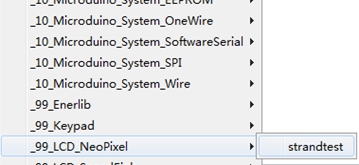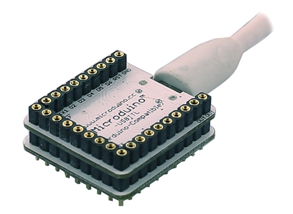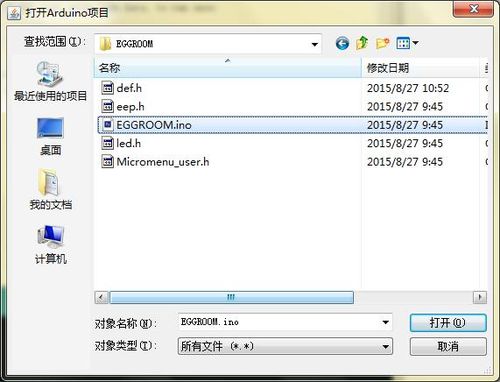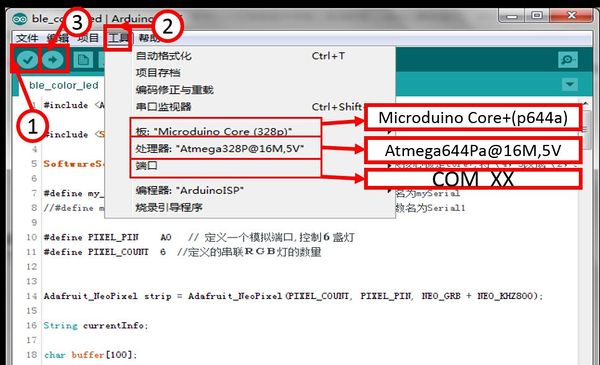“语音情景灯/zh”的版本间的差异
502748957@qq.com(讨论 | 贡献) (→程序说明) |
502748957@qq.com(讨论 | 贡献) |
||
| 第58行: | 第58行: | ||
*语音控制 | *语音控制 | ||
采集并识别语音内容。 | 采集并识别语音内容。 | ||
| − | [[File:Emotionlightstruct.jpg||600px|center | + | [[File:Emotionlightstruct.jpg||600px|center]] |
*主要传感器 | *主要传感器 | ||
*[[Microduino-Lamp/zh]] | *[[Microduino-Lamp/zh]] | ||
套件使用Microduino-Lamp模块作为发光设备,该模块级联了6盏RGB3色彩灯,并可以使用相应的库函数控制每盏彩灯的颜色,为了清晰说明彩灯的控制方法,用一个简单的程序举例。 | 套件使用Microduino-Lamp模块作为发光设备,该模块级联了6盏RGB3色彩灯,并可以使用相应的库函数控制每盏彩灯的颜色,为了清晰说明彩灯的控制方法,用一个简单的程序举例。 | ||
打开Arduino IDE,在文件(File)—>示例(Examples)—>_99_LCD_NeoPixel目录下,点开例程strandtest。 | 打开Arduino IDE,在文件(File)—>示例(Examples)—>_99_LCD_NeoPixel目录下,点开例程strandtest。 | ||
| − | [[File:Emotionlightlib.jpg||600px|center | + | [[File:Emotionlightlib.jpg||600px|center]] |
<source lang="cpp"> | <source lang="cpp"> | ||
#include <Adafruit_NeoPixel.h> | #include <Adafruit_NeoPixel.h> | ||
| 第157行: | 第157行: | ||
将[[Microduino-Core+/zh]]、[[Microduino-USBTTL/zh]]堆叠在一起.用数据线将写好的程序通过[[Microduino-USBTTL/zh]]上传到[[Microduino-Core+/zh]]上。 | 将[[Microduino-Core+/zh]]、[[Microduino-USBTTL/zh]]堆叠在一起.用数据线将写好的程序通过[[Microduino-USBTTL/zh]]上传到[[Microduino-Core+/zh]]上。 | ||
注意:最好不要将所有模块堆叠在一起之后再上传程序 | 注意:最好不要将所有模块堆叠在一起之后再上传程序 | ||
| − | [[File:download1.jpg||600px|center | + | [[File:download1.jpg||600px|center]] |
找到该程序的物理位置,"语音情景灯/ EGGROOM/ EGGROOM.ino",双击即可 | 找到该程序的物理位置,"语音情景灯/ EGGROOM/ EGGROOM.ino",双击即可 | ||
| − | [[File:Emotionlightopen.jpg||600px|center | + | [[File:Emotionlightopen.jpg||600px|center]] |
程序下载 | 程序下载 | ||
点击"√",编译程序。 | 点击"√",编译程序。 | ||
点击【工具】,选择正确的板+处理器+端口。 | 点击【工具】,选择正确的板+处理器+端口。 | ||
点击"→",进行上传。 | 点击"→",进行上传。 | ||
| − | [[File:Downloadselectcore+.jpg||600px|center | + | [[File:Downloadselectcore+.jpg||600px|center]] |
==搭建== | ==搭建== | ||
搭建硬件电路,将用到的设备叠加起来(无上下顺序) | 搭建硬件电路,将用到的设备叠加起来(无上下顺序) | ||
| 第175行: | 第175行: | ||
Microduino-Lamp | Microduino-Lamp | ||
锂电池 | 锂电池 | ||
| − | [[File:Emotionlight1.jpg||600px|center | + | [[File:Emotionlight1.jpg||600px|center]] |
安装发光二极管 | 安装发光二极管 | ||
将发光二极管的负极插在[[Microduino-Sensorhub/zh]]传感器扩展模块的A7管脚,正极插在SDA管脚 | 将发光二极管的负极插在[[Microduino-Sensorhub/zh]]传感器扩展模块的A7管脚,正极插在SDA管脚 | ||
| − | [[File:Emotionlight2.jpg||600px|center | + | [[File:Emotionlight2.jpg||600px|center]] |
将传感器数据线插入第三行第一列插槽,观察这里插线的部分,4根线从左到右分别是GND,VCC,D2,D3接脚(不要看颜色,实物颜色可能与本例不同) | 将传感器数据线插入第三行第一列插槽,观察这里插线的部分,4根线从左到右分别是GND,VCC,D2,D3接脚(不要看颜色,实物颜色可能与本例不同) | ||
| − | [[File:Voidsensor0.jpg||600px|center | + | [[File:Voidsensor0.jpg||600px|center]] |
| − | [[File:Voidcesensor1.jpg||600px|center | + | [[File:Voidcesensor1.jpg||600px|center]] |
安装语音话筒 | 安装语音话筒 | ||
语音话筒无正负极,将两端分别插在语音传感器的MIP和MIN上即可 | 语音话筒无正负极,将两端分别插在语音传感器的MIP和MIN上即可 | ||
| − | [[File:Voidesensor2.jpg||600px|center | + | [[File:Voidesensor2.jpg||600px|center]] |
| − | [[File:Voidsensor3.jpg||600px|center | + | [[File:Voidsensor3.jpg||600px|center]] |
==注意问题== | ==注意问题== | ||
*每次语音输入命令,都要先说f1对应的内容,本例是“美科”读者可根据自己的设置输入 | *每次语音输入命令,都要先说f1对应的内容,本例是“美科”读者可根据自己的设置输入 | ||
2015年11月26日 (四) 02:48的版本
概述
本次教程我们使用Microduino产品模块快速搭建一个可以识别人类语音的灯光控制系统,玩家可以迅速上手,并且可以通过说话,控制灯光模块的亮灭,选色等功能。 材料清单
实验原理语音情景灯模块的原理是记录语音和情景的一一映射关系,通过拼音识别输入的语音,返回给核心对应的情景编号,核心根据得到的情景编号,通过模拟口控制灯光模块每盏led灯的亮灭,实现不同情境下的不同颜色组合。 整个灯光控制系统包括四个部分:
使用[Microduino-BM]电源管理模块和外接电池组合为语音灯供电
中央处理器是语音情景灯系统的核心。采用Microduino-Core+作为核心。
语音情景灯系统采用Bluetooth无线通讯方案,使用[Microduino-BT(4.0)]模块,通讯速度响应快,在空阔地域的控制范围大概8米左右。
采集并识别语音内容。
套件使用Microduino-Lamp模块作为发光设备,该模块级联了6盏RGB3色彩灯,并可以使用相应的库函数控制每盏彩灯的颜色,为了清晰说明彩灯的控制方法,用一个简单的程序举例。 打开Arduino IDE,在文件(File)—>示例(Examples)—>_99_LCD_NeoPixel目录下,点开例程strandtest。 #include <Adafruit_NeoPixel.h>
#define PIN 6 //定义控制引脚
// 参数 1 = strip中彩灯的数目
// 参数 2 = 引脚号
// 参数 3 = 彩灯类型, 可多选(前两个中选一个,后两个中选一个):
// NEO_RGB Pixels are wired for RGB bitstream
// NEO_GRB Pixels are wired for GRB bitstream
// NEO_KHZ400 400 KHz bitstream (e.g. FLORA pixels)
// NEO_KHZ800 800 KHz bitstream (e.g. High Density LED strip)
Adafruit_NeoPixel strip = Adafruit_NeoPixel(60, PIN, NEO_GRB + NEO_KHZ800);
void setup()
{
strip.begin();
strip.show(); //初始化所有彩灯都为灭
}
void loop()
{
// 点亮彩灯的方法
colorWipe(strip.Color(255, 0, 0), 50); // 点亮红色
colorWipe(strip.Color(0, 255, 0), 50); // 点亮绿色
colorWipe(strip.Color(0, 0, 255), 50); // 点亮蓝色
rainbow(20);
rainbowCycle(20);
}
//用“c”所代表的颜色依次点亮各盏彩灯,每点亮一盏等“wait”秒
void colorWipe(uint32_t c, uint8_t wait)
{
for(uint16_t i = 0; i < strip.numPixels(); i++) //依次点亮
{
strip.setPixelColor(i, c); //这个函数用于把第i盏灯用“c”所指颜色点亮
strip.show(); //这个函数会将setPixelColor函数所写入的控制信息显示
//出来,也就是靠它点亮LAMP模块
delay(wait);
}
}
void rainbow(uint8_t wait) //彩虹显示
{
uint16_t i, j;
for(j = 0; j < 256; j++) //渐变255种颜色
{
for(i = 0; i < strip.numPixels(); i++) //依次点亮彩灯,间隔wait毫秒
{
strip.setPixelColor(i, Wheel((i + j) & 255));
}
strip.show();
delay(wait);
}
}
// 与上面的函数稍有区别,添加了彩虹的循环
void rainbowCycle(uint8_t wait)
{
uint16_t i, j;
for(j = 0; j < 256 * 5; j++) //彩虹循环5次
{
for(i = 0; i < strip.numPixels(); i++)
{
strip.setPixelColor(i, Wheel(((i * 256 / strip.numPixels()) + j) & 255)); //为了循环而添加的数学变换
}
strip.show();
delay(wait);
}
}
// 输入0-255任意一个数得到对应的唯一的一种颜色
// 颜色会从红-绿->蓝->红依次渐变循环
uint32_t Wheel(byte WheelPos)
{
if(WheelPos < 85)
{
return strip.Color(WheelPos * 3, 255 - WheelPos * 3, 0);
}
else if(WheelPos < 170)
{
//因为WheelPos * 3在85到170的情况下会超过255,因此要先自减85
WheelPos -= 85;
return strip.Color(255 - WheelPos * 3, 0, WheelPos * 3);
}
else
{
//因为WheelPos * 3在170以上的情况下会超过255,因此要先自减170
WheelPos -= 170;
return strip.Color(0, WheelPos * 3, 255 - WheelPos * 3);
}
文档调试过程
将Microduino-Core+/zh、Microduino-USBTTL/zh堆叠在一起.用数据线将写好的程序通过Microduino-USBTTL/zh上传到Microduino-Core+/zh上。 注意:最好不要将所有模块堆叠在一起之后再上传程序 找到该程序的物理位置,"语音情景灯/ EGGROOM/ EGGROOM.ino",双击即可 程序下载 点击"√",编译程序。 点击【工具】,选择正确的板+处理器+端口。 点击"→",进行上传。 搭建搭建硬件电路,将用到的设备叠加起来(无上下顺序) Microduino-Core+ Microduino-USBTTL Microduino-BT(4.0) Microduino-BM Microduino-Duo-H Microduino-sensorhub Microduino-Lamp 锂电池 安装发光二极管 将发光二极管的负极插在Microduino-Sensorhub/zh传感器扩展模块的A7管脚,正极插在SDA管脚 将传感器数据线插入第三行第一列插槽,观察这里插线的部分,4根线从左到右分别是GND,VCC,D2,D3接脚(不要看颜色,实物颜色可能与本例不同) 安装语音话筒 语音话筒无正负极,将两端分别插在语音传感器的MIP和MIN上即可 注意问题
程序说明
#include "Arduino.h"
#include "audio.h"
#include "JQ6500.h"
#include "JQ6500_def.h"
#include "def.h"
#include <Wire.h>
#include <AM2321.h>
#include <Adafruit_NeoPixel.h>
//用户自定义部分------------------------
AM2321 am2321;
//用户自定义部分------------------------
#define PIN A0
#define NOTICE A2
Adafruit_NeoPixel strip = Adafruit_NeoPixel(6, PIN, NEO_GRB + NEO_KHZ800);
Adafruit_NeoPixel notice = Adafruit_NeoPixel(6, NOTICE, NEO_GRB + NEO_KHZ800);
uint32_t color[9] =
{
strip.Color(0, 0, 0), strip.Color(255, 0, 0), strip.Color(248, 141, 30), strip.Color(255, 255, 0),
strip.Color(0, 255, 0), strip.Color(0, 127, 255),
strip.Color(0, 0, 255), strip.Color(139, 0, 255), strip.Color(255, 255, 255)
};
//用户自定义部分------------------------
int music_vol = 25; //初始音量0~30
int music_Mode = MODE_ONE_STOP;
JQ6500 AUDIO(&VOICE); //声明audio类
//用户自定义部分------------------------
int num = 0;
boolean buffer_sta = false;
boolean start = false;
int brightness = 255;
unsigned long timer_voice = millis();
int flag_on = 0;
int c = 0;
int DHTPIN = 8;
int temperature;
//func===================================
int judge(String cmd);
void writecommand();
void colorWipe(uint32_t c);
void dht11();
void tempsound();
//SETUP===================================
void SETUP_begin()
{
DEBUG.begin(9600);
VOICE.begin(9600);
VOICE.begin(9600);
pinMode(DHTPIN,INPUT);
//EEPROM---------------------
config = eeprom_READ();
music_Mode = config.EEPROM_music_mode;
music_vol = config.EEPROM_music_vol;
AUDIO.init(DEVICE_TF, music_Mode, music_vol);
delay(1000);
// AUDIO.choose(1);
AUDIO.pause();
strip.begin(); //初始化LED
notice.begin();
pinMode(6,OUTPUT);
notice.setPixelColor(0, strip.Color(0, 0, 0));
notice.show();
for (int i = 0; i < 6; i++) // 初始化所有灯都为灭
{
strip.setPixelColor(i, strip.Color(0, 0, 0));
strip.show();
}
writecommand(); //语音模块配置
}
//LOOP====================================
void LOOP_priority_1ST()
{
if (millis() < timer_voice) {
timer_voice = millis(); //同步
}
if (millis() - timer_voice < 10000) //从有配置指令声音输入开始计时
{
notice.setPixelColor(0,notice.Color(255, 255, 255));
notice.show();
}
else
{
notice.setPixelColor(0,notice.Color(0, 0, 0));
notice.show();
flag_on = 0;
}
if (VOICE.available())
{
String cmd = "";
if (VOICE.available()) //如果从语音芯片接收到用户的语音输入数据
{
cmd += char(VOICE.read()); //读出串口内的内容
delay(10);
cmd += char(VOICE.read());
delay(10);
}
Serial.println(flag_on);
Serial.println(cmd);
if (cmd == "pp") //如果是语音开关指令对应的内容
{
DEBUG.println("Voice IN!"); //在串口提示 输入声音
AUDIO.choose(1);
delay(2000);
AUDIO.pause();
flag_on = 1;
notice.Color(0, 0, 0);
timer_voice = millis(); //记录当前的系统运行时间
}
if (flag_on) //如果进入了语音输入状态
{
c = judge(cmd);
DEBUG.print("C is :");
DEBUG.println(c);
switch (c) //根据不同的语音指令,选择对应的应答
{
case 1: //名字
timer_voice = 0;
AUDIO.choose(4);
timer_voice = millis();
break;
case 2: //年龄
timer_voice = 0;
AUDIO.choose(6);
timer_voice = millis();
break;
case 3: //讲故事
timer_voice = 0;
AUDIO.choose(3);
timer_voice = millis();
delay(9000); //防止误触发打断
break;
case 4: //背诗
timer_voice = 0;
AUDIO.choose(2);
delay(3000);
AUDIO.choose(5);
delay(10000);
timer_voice = millis();
break;
case 5: //天气如何
timer_voice = 0;
am2321.read();
temperature = am2321.temperature/10.0;
Serial.println(temperature);
if(temperature<20)AUDIO.choose(15);
if(temperature>=20&&temperature<27)AUDIO.choose(14);
if(temperature>=27)AUDIO.choose(16);
timer_voice = millis();
break;
case 6: //好黑
timer_voice = 0;
AUDIO.choose(9);
colorWipe(color[8]);
timer_voice = millis();
break;
case 7: //再见
timer_voice = 0;
AUDIO.choose(11);
timer_voice = millis();
break;
case 8: //傻瓜
timer_voice = 0;
AUDIO.choose(12);
timer_voice = millis();
break;
case 9: //关灯
timer_voice = 0;
AUDIO.choose(10); //好的
colorWipe(color[0]);
timer_voice = millis();
break;
case 10: //谢谢
timer_voice = 0;
AUDIO.choose(13); //不客气
timer_voice = millis();
break;
case 11: //吹泡
timer_voice = 0;
digitalWrite(6,HIGH);
delay(8000);
digitalWrite(6,LOW);
timer_voice = millis();
break;
case 0:
timer_voice = 0;
AUDIO.pause();
timer_voice = millis();
break;
}
while (VOICE.available()){
VOICE.read();}
}
}
}
int judge(String cmd)
{
int c;
if (cmd == mz)c = 1;
if (cmd == nl)c = 2;
if (cmd == gs)c = 3;
if (cmd == sg)c = 4;
if (cmd == wd)c = 5;
if (cmd == kd)c = 6;
if (cmd == zj)c = 7;
if (cmd == sm)c = 8;
if (cmd == gd)c = 9;
if (cmd == xx)c = 10;
if(cmd == cp)c = 11;
if (cmd == "pp") {
c = 0;
}
return c;
}
void writecommand()
{
VOICE.println("{d1}");
delay(200);
VOICE.println("{d1}"); //确认进入调试模式
delay(200);
VOICE.println("{c0}"); //清除已有指令
delay(200);
VOICE.println("{a0pao pao|s0pp}"); //开启语音指令
delay(200);
VOICE.println("{a0ni de ming zi|s0mz}"); //你的名字
delay(200);
VOICE.println("{a0ni de nian ling|s0nl}"); // 你的年龄
delay(200);
VOICE.println("{a0jiang gu shi|s0gs}"); //讲故事
delay(200);
VOICE.println("{a0bei shi|s0sg}"); //背诗
delay(200);
VOICE.println("{a0sha gua|s0sm}"); //傻瓜
delay(200);
// VOICE.println("{a0tian qi ru he|s0wd}"); //天气如何
// delay(200);
VOICE.println("{a0kai deng|s0kd}"); //开灯
delay(200);
VOICE.println("{a0guan deng|s0gd}"); //关灯
delay(200);
VOICE.println("{a0zai jian|s0zj}"); //再见
delay(200);
VOICE.println("{a0xie xie|s0xx}"); //谢谢
delay(200);
VOICE.println("{l0}"); //加载
delay(200);
VOICE.println("{d0}"); //退出调试
delay(200);
}
void colorWipe(uint32_t c) {
for (uint16_t i = 0; i < strip.numPixels(); i++)
{
strip.setPixelColor(i, c);
strip.show();
}
}
#include "Arduino.h"
#include <SoftwareSerial.h>
//定义蓝牙通信串口
//SoftwareSerial mySerial(4, 5); // RX, TX
//定义串口
//#define YUYIN mySerial
#define VOICE Serial1
#define DEBUG Serial
String mz = "mz";
String nl = "nl";
String gs = "gs";
String sg = "sg";
String wd = "wd";
String kd = "kd";
String zj = "zj";
String sm = "sm";
String gd = "gd";
String xx = "xx";
String zl = "zl";
String cp = "cp";
int led_style=2;
int led_style_vol=2;
//int led_style_cache=0;
boolean led_sta=true;
//定义亮度
#define led_brightness 3
unsigned long led_time;
//
// JQ6500 audio library for Arduino
//
#include "JQ6500.h"
#include "JQ6500_def.h"
#include <SoftwareSerial.h>
JQ6500::JQ6500(SoftwareSerial *ser) {
common_init();
audioSwSerial = ser;
}
JQ6500::JQ6500(HardwareSerial *ser) {
common_init();
audioHwSerial = ser;
}
void JQ6500::common_init(void){
audioSwSerial = NULL;
audioHwSerial = NULL;
}
void JQ6500::begin(uint16_t baud){
if(audioSwSerial) audioSwSerial->begin(baud);
else audioHwSerial->begin(baud);
delay(10);
}
void JQ6500::sendCommand(uint8_t cmd, uint8_t *buf, uint16_t len){
sendBuffer[0] = STX;
sendBuffer[1] = len+2;
sendBuffer[2] = cmd;
if(len > 0)
memcpy(sendBuffer+3, buf, len);
sendBuffer[len+3] = ETX;
if(audioSwSerial)
audioSwSerial->write(sendBuffer, 4+len);
else
audioHwSerial->write(sendBuffer, 4+len);
delay(100);
}
void JQ6500::next(){
sendCommand(CMD_NEXT, NULL, 0);
}
void JQ6500::prev(){
sendCommand(CMD_PREV, NULL, 0);
}
void JQ6500::choose(uint16_t num){
cmdBuffer[0] = num>>8;
cmdBuffer[1] = num&0x00FF;
sendCommand(CMD_CHOOSE, cmdBuffer, 2);
}
void JQ6500::volUp(){
sendCommand(CMD_UP, NULL, 0);
}
void JQ6500::volDown(){
sendCommand(CMD_DOWN, NULL, 0);
}
void JQ6500::volumn(uint8_t vol){
cmdBuffer[0] = vol;
sendCommand(CMD_VOL, cmdBuffer, 1);
}
void JQ6500::eq(uint8_t eq){
cmdBuffer[0] = eq;
sendCommand(CMD_EQ, cmdBuffer, 1);
}
void JQ6500::setDevice(uint8_t device){
cmdBuffer[0] = device;
sendCommand(CMD_DEVICE, cmdBuffer, 1);
}
void JQ6500::sleep(){
sendCommand(CMD_SLEEP, NULL, 0);
}
void JQ6500::reset(){
sendCommand(CMD_RESET, NULL, 0);
}
void JQ6500::play(){
sendCommand(CMD_PLAY, NULL, 0);
}
void JQ6500::pause(){
sendCommand(CMD_PAUSE, NULL, 0);
}
void JQ6500::folder(uint8_t temp){
cmdBuffer[0] = temp;
sendCommand(CMD_FOLDER, cmdBuffer, 1);
}
void JQ6500::setMode(uint8_t temp){
cmdBuffer[0] = temp;
sendCommand(CMD_MODE, cmdBuffer, 1);
}
void JQ6500::chooseFile(uint8_t folder, uint8_t file){
cmdBuffer[0] = folder;
cmdBuffer[1] = file;
sendCommand(CMD_FILE, cmdBuffer, 2);
}
void JQ6500::init(uint8_t device, uint8_t mode, uint8_t vol){
begin(9600);
delay(300);
reset();
setDevice(device);
setMode(mode);
volumn(vol);
}
uint16_t JQ6500::dataParse(){
uint16_t sum = 0;
uint8_t temp;
if(audioSwSerial){
while(audioSwSerial->available()){
temp = char(audioSwSerial->read());
if(temp>47&&temp<58){
temp -=48;
}else if(temp>96&&temp<103){
temp -=87;
}
sum = sum*16+temp;
}
}else{
while(audioHwSerial->available()){
temp = char(audioHwSerial->read());
if(temp>47&&temp<58){
temp -=48;
}else if(temp>96&&temp<103){
temp -=87;
}
sum = sum*16+temp;
}
}
return sum;
}
uint16_t JQ6500::queryNum(uint8_t cmd){
if(audioSwSerial)
audioSwSerial->flush();
else
audioHwSerial->flush();
sendCommand(cmd, NULL, 0);
delay(100);
return dataParse();
}
uint16_t JQ6500::queryTF(){
return queryNum(QUERY_TF);
}
uint16_t JQ6500::queryTFFile(){
return queryNum(QUERY_TF_FILE);
}
uint16_t JQ6500::queryFlash(){
return queryNum(QUERY_FLASH);
}
uint16_t JQ6500::queryFlashFile(){
return queryNum(QUERY_FLASH_FILE);
}
uint16_t JQ6500::queryTotalTime(){
return queryNum(QUERY_TTIME);
}
uint16_t JQ6500::queryPlayTime(){
return queryNum(QUERY_PTIME);
}
String JQ6500::queryName(){
String nameCache = "";
char temp;
uint16_t i = 0;
if(audioSwSerial)
audioSwSerial->flush();
else
audioHwSerial->flush();
sendCommand(QUERY_NAME, NULL, 0);
delay(100);
if(audioSwSerial){
while(audioSwSerial->available()){
temp = audioSwSerial->read();
nameCache += temp;
if(temp == 32){
i++;
}else{
i = 0;
}
if(i >= 3){
i = 0;
nameCache.replace(" ", ".");
}
}
}else{
while(audioHwSerial->available()){
temp = audioHwSerial->read();
nameCache += temp;
if(temp == 32){
i++;
}else{
i = 0;
}
if(i >= 3){
i = 0;
nameCache.replace(" ", ".");
}
}
}
return nameCache;
}
//
// END OF FILE
//
//
// JQ6500 audio library for Arduino
// VERSION: 0.1.0
//
#ifndef __JQ6500_H__
#define __JQ6500_H__
#include <Arduino.h>
#include <SoftwareSerial.h>
#define AUDIO_VERSION "0.1.0"
#define STX 0x7E
#define ETX 0xEF
#define CMD_NEXT 0x01
#define CMD_PREV 0x02
#define CMD_CHOOSE 0x03
#define CMD_UP 0x04
#define CMD_DOWN 0x05
#define CMD_VOL 0x06
#define CMD_EQ 0x07
#define CMD_DEVICE 0x09
#define CMD_SLEEP 0x0A
#define CMD_RESET 0x0C
#define CMD_PLAY 0x0D
#define CMD_PAUSE 0x0E
#define CMD_FOLDER 0x0F
#define CMD_MODE 0x11
#define CMD_FILE 0x12
#define QUERY_STA 0x42
#define QUERY_VOL 0x43
#define QUERY_EQ 0x44
#define QUERY_MODE 0x45
#define QUERY_VERSION 0x46
#define QUERY_TF 0x47
#define QUERY_DISK 0x48
#define QUERY_FLASH 0x49
#define QUERY_TF_FILE 0x4B
#define QUERY_DISK_FILE 0x4C
#define QUERY_FLASH_FILE 0x4D
#define QUERY_PTIME 0x50
#define QUERY_TTIME 0x51
#define QUERY_NAME 0x52
#define QUERY_FILES 0x53
class JQ6500{
public:
JQ6500(SoftwareSerial *ser);
JQ6500(HardwareSerial *ser);
void begin(uint16_t baud);
void next();
void prev();
void choose(uint16_t num);
void volUp();
void volDown();
void volumn(uint8_t vol);
void eq(uint8_t eq);
void setDevice(uint8_t device);
void sleep();
void reset();
void play();
void pause();
void folder(uint8_t temp);
void setMode(uint8_t temp);
void chooseFile(uint8_t folder, uint8_t file);
void init(uint8_t device, uint8_t mode, uint8_t vol);
uint16_t queryTF();
uint16_t queryTFFile();
uint16_t queryFlash();
uint16_t queryFlashFile();
uint16_t queryTotalTime();
uint16_t queryPlayTime();
String queryName();
private:
uint8_t sendBuffer[8];
uint8_t cmdBuffer[8];
SoftwareSerial *audioSwSerial;
HardwareSerial *audioHwSerial;
void common_init(void);
void sendCommand(uint8_t cmd, uint8_t *buf, uint16_t len);
uint16_t dataParse();
uint16_t queryNum(uint8_t cmd);
};
#endif
//
// END OF FILE
//
JQ6500_def.h //
// AM2321 Temperature & Humidity Sensor library for Arduino
// VERSION: 0.1.0
//
// The MIT License (MIT)
//
// Copyright (c) 2013 Wang Dong
//
// Permission is hereby granted, free of charge, to any person obtaining a copy
// of this software and associated documentation files (the "Software"), to deal
// in the Software without restriction, including without limitation the rights
// to use, copy, modify, merge, publish, distribute, sublicense, and/or sell
// copies of the Software, and to permit persons to whom the Software is
// furnished to do so, subject to the following conditions:
//
// The above copyright notice and this permission notice shall be included in
// all copies or substantial portions of the Software.
//
// THE SOFTWARE IS PROVIDED "AS IS", WITHOUT WARRANTY OF ANY KIND, EXPRESS OR
// IMPLIED, INCLUDING BUT NOT LIMITED TO THE WARRANTIES OF MERCHANTABILITY,
// FITNESS FOR A PARTICULAR PURPOSE AND NONINFRINGEMENT. IN NO EVENT SHALL THE
// AUTHORS OR COPYRIGHT HOLDERS BE LIABLE FOR ANY CLAIM, DAMAGES OR OTHER
// LIABILITY, WHETHER IN AN ACTION OF CONTRACT, TORT OR OTHERWISE, ARISING FROM,
// OUT OF OR IN CONNECTION WITH THE SOFTWARE OR THE USE OR OTHER DEALINGS IN
// THE SOFTWARE.
//
#ifndef __JQ6500_DEF_H__
#define __JQ6500_DEF_H__
#define EQ_NORMAL 0x00
#define EQ_POP 0x01
#define EQ_ROCK 0x02
#define EQ_JAZZ 0x03
#define EQ_CLASSIC 0x04
#define EQ_BASE 0x05
#define DEVICE_U 0x00
#define DEVICE_TF 0x01
#define DEVICE_AUX 0x02
#define DEVICE_SLEEP 0x03
#define DEVICE_FLASH 0x04
#define MODE_ALL 0x00
#define MODE_FOL 0x01
#define MODE_ONE 0x02
#define MODE_RAM 0x03
#define MODE_ONE_STOP 0x04
#endif
//
// END OF FILE
//
Audio.h #include "arduino.h"
#include <EEPROM.h>
#define EEPROM_write(address, p) {int i = 0; byte *pp = (byte*)&(p);for(; i < sizeof(p); i++) EEPROM.write(address+i, pp[i]);}
#define EEPROM_read(address, p) {int i = 0; byte *pp = (byte*)&(p);for(; i < sizeof(p); i++) pp[i]=EEPROM.read(address+i);}
struct config_type
{
int EEPROM_music_mode;
int EEPROM_music_vol;
};
config_type config; // 定义结构变量config,并定义config的内容
void eeprom_WRITE(int mode, int vol)
{
config_type config; // 定义结构变量config,并定义config的内容
config.EEPROM_music_mode=mode;
config.EEPROM_music_vol=vol;
EEPROM_write(0, config); // 变量config存储到EEPROM,地址0写入
}
config_type eeprom_READ()
{
config_type config_readback;
EEPROM_read(0, config_readback);
return config_readback;
}
</cpp>
<source lang="cpp">
#include "arduino.h"
int vol,volCache;
unsigned long time_cache=0;
int keyRead()
{
if(analogRead(A6)<10)
{
delay(50);
if(analogRead(A6)<10)
return 1;
}
if(analogRead(A6)>200 && analogRead(A6)<300)
{
delay(50);
if(analogRead(A6)>200 && analogRead(A6)<300)
return 2;
}
if(analogRead(A6)>300 && analogRead(A6)<400)
{
delay(50);
if(analogRead(A6)>300 && analogRead(A6)<400)
return 3;
}
return 0;
}
int keyGet()
{
int key = 0;
vol = keyRead(); //检测输入动作
if(vol==0){
if(volCache == 1){
key = 1;
}else if(volCache > 1){
key = volCache + 3;
}else{
key = 0;
}
time_cache=millis();
}
volCache = vol;
if(millis() > time_cache + 1000){
key = vol + 1;
volCache = 0;
}
return key;
}
视频 |



